“Plasma cutting is a precise and efficient method for shaping and fabricating corrosion-resistant materials. It enables manufacturers to achieve intricate designs and precise cuts in stainless steel for various industrial applications.”
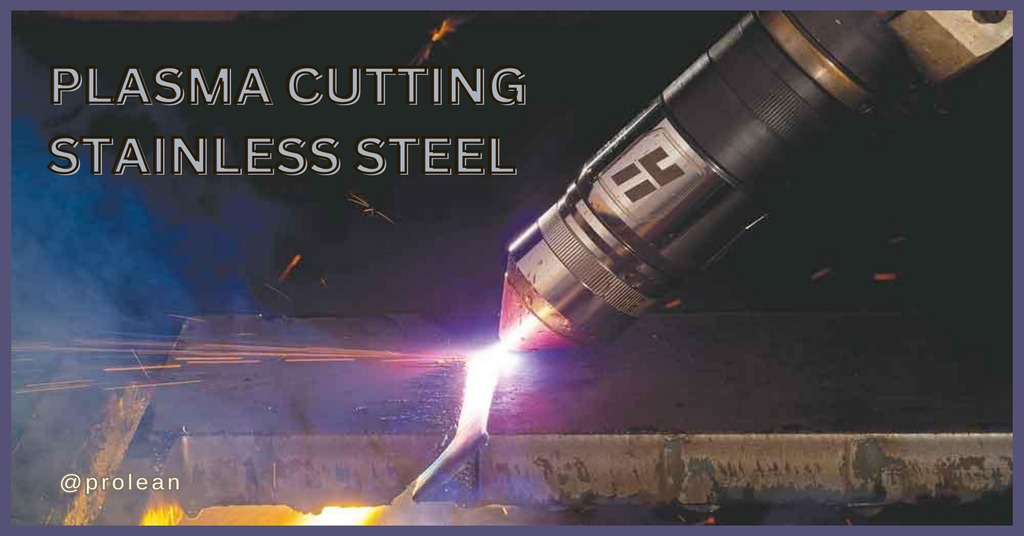
Plasma cutting is known for its advanced technical aspects like the expanded range of gas utilization to produce optimal cuts. When it comes to the capabilities of plasma in cutting stainless steel, the answer lies in its exceptional machinability. Moreover, stainless steel is renowned for its exceptional characteristics for instance corrosion resistance, durability, strength, and weldability. These features make it a popular material for a variety of applications, and plasma cutting allows stainless steel to precisely create complicated shapes and designs.
In this article, we will discuss the enormous potential of plasma-cutting stainless steel, and its techniques suitable for penetrating plasma. Furthermore, we’ll examine the merits, and demerits, and discuss achieving the perfect finish
Why Plasma for Cutting?
Plasma is known for its malleability and distinguished features to cut conductive metals like steel, aluminum, brass, nickel, etc. High Precision rates and accuracies are quite easy to achieve by utilizing Plasma in cutting.
Moreover, plasma produces highly smooth cuts without excessive heat or wear on targetted metal. It offers smooth surface finishes with minimal residue and heat-affected zones.
Additionally, plasma consumes less energy, produces less waste, and requires minimal maintenance, resulting in lower operational costs over time. Furthermore, modern plasma cutting systems incorporate safety features such as automatic torch height control and overload protection. These features make it an exceptional choice for framing sophisticated designs.
What is Plasma Cutting Stainless Steel?
In order to fabricate stainless steel into the desired shape, plasma is the right choice. Plasma-cutting stainless steel is like using a super-hot torch to slice through the metal.
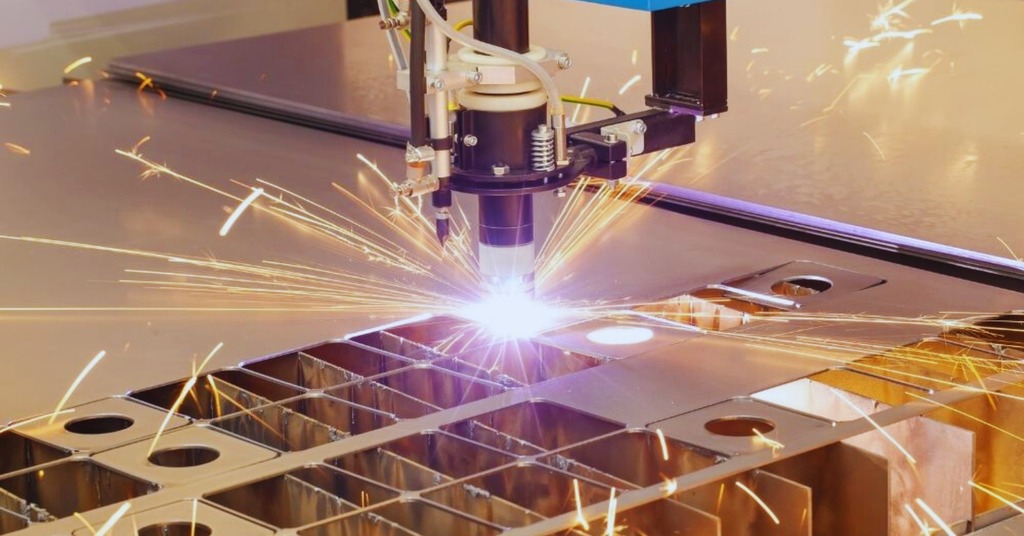
Plasma cutting of stainless steel
How does Plasma cut stainless steel? Let’s elaborate it in a few steps;
- First of all, plasma uses a high-velocity ionized gas shot through a focused nozzle.
- Then, a conductive channel of high-temperature plasma is formed when an electrical arc ionizes the gas.
- After that, this high-velocity plasma passes via the nozzle at a fast pace toward the workpiece.
- At last, high heat melts the metal, and a high-velocity stream of gas blows away molten material resulting in an impeccable and precise cut.
- Plasma offers an economical and speedy cutting option when compared to laser cutting and waterjet cutting.
Try Prolean Now!
What Grades of Stainless Steel are Best for Plasma Cutting?
The suitability factor for grade selection depends on various factors such as the thickness of the material, the desired cut quality, and weldability. In this context, grades belonging to the austenitic family are most popular due to their excellent weldability.
Here are the most commonly employed stainless steel grades that suit best for plasma cutting are;
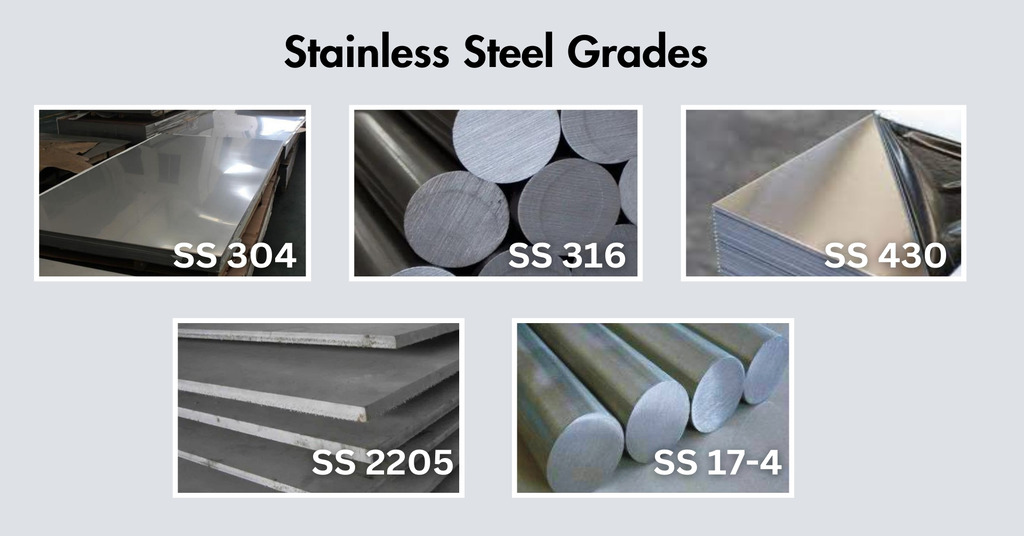
Stainless Steel Grades for Plasma Cutting
Stainless Steel 304 (A2)
Stainless steel 304 belongs to the austenitic family and is most commonly used for plasma cutting. It offers good corrosion resistance and superior weldability.
It is most suitable for a wide range of applications in industries such as food processing, chemical processing, and architectural designs. Moreover, Stainless steel 304 provides a balance of performance and cost-effectiveness.
Stainless Steel 316 (A4)
Another popular austenitic stainless steel grade is stainless steel 316. It exhibits exceptional corrosion resistance than 304, particularly in harsh environments containing chlorides or acids. It is often used in marine applications, pharmaceutical equipment, and medical devices. Furthermore, Stainless steel 316 offers good mechanical properties, including high tensile strength and durability, making it suitable for structural and load-bearing applications.
Stainless Steel 430
This ferritic stainless steel grade is renowned for its good corrosion resistance and high-temperature oxidation resistance abilities. It is commonly used in applications such as automotive trim, kitchen appliances, and architectural components. It is suitable for plasma cutting, especially for thinner sections.
Stainless Steel 2205 (Duplex)
Duplex stainless steel grades like 2205 offer a combination of high strength and excellent corrosion resistance, making them suitable for demanding applications such as chemical processing, oil and gas, and marine environments. While duplex stainless steels can be more challenging to plasma cut due to their higher alloy content, they can still be cut effectively with proper equipment and settings.
Stainless Steel 17-4 PH
This precipitation-hardening stainless steel grade offers high strength, excellent corrosion resistance, and good mechanical properties. It is often used in aerospace components, pump shafts, and valve parts, and can be plasma cut effectively with appropriate cutting parameters.
Gases For Stainless Steel Plasma Cutting
When it comes to plasma-cutting stainless steel, the choice of gases plays a crucial role in achieving optimal cutting results. The primary gases used for plasma cutting stainless steel include;
1. Nitrogen
Among the gases commonly used for this purpose, nitrogen (N2) stands out for its non-reactive nature and its ability to produce clean cuts with minimal oxide formation.
The use of nitrogen as plasma gas allows professional cutters to benefit from cost savings and more flexibility. This makes it particularly suitable for cutting thin stainless steel sheets where maintaining the integrity of the material surface is essential.
Nitrogen offers excellent control over the cutting process, helping to minimize heat-affected zones and ensuring precise cuts with minimal distortion. Its inert properties make it an ideal choice for applications requiring high-quality finishes. Use nitrogen gas where oxidation or discoloration of the cut edges is undesirable.
2. Argon
An argon-hydrogen mixture (Ar-H2) is also favored for plasma-cutting stainless steel. The plasma cutters utilize argon when they need to cut thicker sections in metal pieces.
This gas combination, typically with a hydrogen content ranging from 35% to 50%, provides distinct advantages over pure nitrogen. Moreover, the addition of hydrogen to argon enhances the cutting performance by increasing the heat input and improving arc stability. As a result, plasma cutting with an argon-hydrogen mixture allows for higher cutting speeds and increased productivity, making it well-suited for cutting thicker stainless steel sections.
The increased heat input from the hydrogen also aids in piercing through thicker materials more effectively, resulting in smoother starts and faster cutting speeds.
3. Oxygen
Oxygen is useful for plasma-cutting stainless steel, especially for cutting thicker sections. When oxygen is used as the plasma gas in plasma cutting, oxygen can accelerate the cutting speed and increase the heat input to the material. This results in faster cutting rates and improved productivity, particularly for stainless steel sections that are 6 mm (1/4 inch) thick and above.
Oxygen reacts with the metal during the cutting process, producing exothermic reactions that enhance the cutting action. This increased heat input from the oxygen plasma stream allows for faster melting of the stainless steel, facilitating more efficient cutting.
Additionally, the exothermic reaction helps to blow away molten metal and slag from the kerf, resulting in cleaner cuts with minimal dross and smoother edges.
Try Prolean Now!
Gases Selection Guide For Plasma Cutting
Understanding the role of different gases in plasma cutting is crucial for achieving clean, precise cuts and maximizing efficiency in metal fabrication processes
Table: Plasma Gas Compatibility Guide for Various Metals
| Plasma Gas | Compatible Metals | Selection Guide |
| Nitrogen (N2) | Stainless steel, Aluminum, Copper | Use when clean cuts with minimal oxide formation are essential, suitable for thin stainless steel sheets (up to 6 mm). |
| Argon (Ar) | Stainless steel, Brass, Titanium, Nickel Alloys | Use when minimal distortion and clean edges are desired, ideal for cutting thick stainless steel sections (6 mm and above). |
| Argon-Hydrogen | Stainless steel, Copper, Brass, Titanium | Use when improved cutting speed and productivity are needed, suitable for cutting thick stainless steel sections (6 mm and above). |
| Oxygen (O2) | Stainless steel, Aluminum | Use when increased productivity and accelerated cutting speed is desired, suitable for cutting thick stainless steel sections (6 mm and above). |
| Air | Stainless steel, Mild steel | Use when cost-effectiveness is a priority, suitable for cutting stainless steel with moderate thickness (up to 12 mm), where the cost of gases is a concern. |
Other Materials for Plasma Cutting than Stainless Steel
Plasma cutting is a versatile process that can be used to cut a wide range of metals besides steel. Here are some of the other metals commonly cut using plasma cutting:
1. Aluminum
Aluminum is a lightweight metal known for its high strength-to-weight ratio and excellent corrosion resistance. Aluminum is an excellent conductor of electricity. This property makes it sound for plasma cutting, which also makes aluminum plasma cutting popular.
Compared to some other metals, aluminum is relatively easy to cut using plasma because of its lower melting point and softer properties. Plasma cutting is frequently used to cut aluminum sheets and plates for applications in industries such as aerospace, automotive, and marine.
2. Copper
Copper is a highly conductive metal with excellent electrical and thermal properties. Plasma cutting is utilized to cut copper sheets and components for electrical and electronic applications, as well as artistic and decorative purposes.
Due to its excellent conductivity and heat transfer properties, copper can be cut with high precision using plasma technology. This is important for applications requiring intricate designs or tight tolerances.
3. Brass
Brass retains some of the high conductivity properties of copper, making it feasible for plasma cutting. While it may not conduct electricity as effectively as pure copper, it still allows for the generation of a plasma arc during cutting. Plasma cutting is commonly employed in cutting brass sheets and components for architectural, decorative, and industrial applications.
Techniques for Stainless Steel Plasma Cutting
When it comes to plasma cutting stainless steel, several cutting techniques are commonly employed to achieve the desired results.
1- Conventional plasma cutting
In conventional plasma cutting of stainless steel with air, the process starts by setting up the plasma cutter and igniting an electric arc to create a super-hot plasma jet from the surrounding air.
This plasma then melts through the stainless steel as the operator guides the torch along the cutting path. A stream of air blows away the molten metal, creating a clean cut. Precision is maintained by controlling the torch’s motion. Once cutting is done, the plasma arc is turned off, and the torch is moved away.
While cost-effective, air plasma cutting may not produce as clean cuts as other gases like nitrogen or oxygen, requiring proper ventilation for safety and quality. It is cheaper to operate.
2- High-precision plasma cutting
High-precision plasma cutting is like using a super-precise laser to cut stainless steel. Instead of a laser, it uses a special torch that shoots out a really hot stream of plasma (a supercharged gas). This plasma is so hot that it melts through the stainless steel, cutting it into precise shapes.
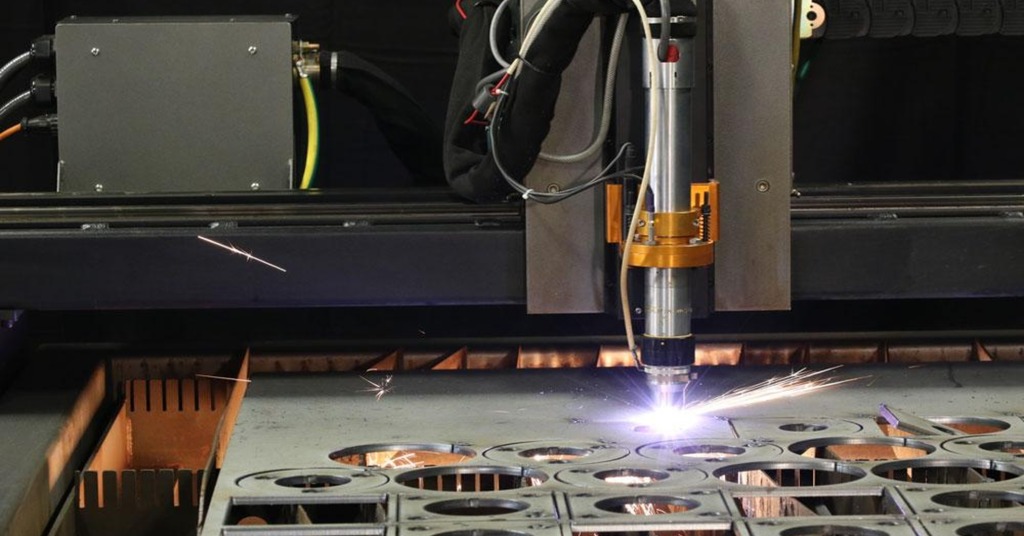
High Precision Plasma Cutting
What makes high-precision plasma cutting different from regular plasma cutting is its incredible accuracy. The machine is super smart and can control the plasma torch very precisely, so it cuts exactly where it’s supposed to, without any mistakes.
Because of this accuracy, high-precision plasma cutting can make really thin cuts with almost no wasted material. It also leaves behind smooth edges, so there’s no need for extra polishing or cleaning.
3- Dual Gas Plasma Cutting
Dual gas plasma cutting typically uses a combination of two gases. Its efficiency is enhanced by using oxygen along with an inert gas. Oxygen reacts with metal and produces a high-temperature plasma arc while inert gas improves and shields the overall cut.
The dual gas cutting technique has advantages for instance increased precision, and reduced ash formation. It is ideally used in shipbuilding, and construction, where a balance between speed and high-quality cuts is important.
4- CNC Plasma Cutting
In CNC (Computer Numerical Control), a computer guides the plasma torch along a specified path. CNC consists of a straight torch, carried by a machine and controlled autonomously by the computer based on numerical coding in a program. The CNC technique is famous for its precision and automation capabilities.
For CNC, the workability of technique and material is quite important. A CNC plasma-cutting stainless steel supplier is the best fit for this purpose. This supplier possesses a complete understanding of stainless steel traits and uses advanced CNC techniques.
Try Prolean Now!
Advantages of Plasma Cutting Stainless Steel
Here are some of the merits of plasma cutting;
- Plasma cutting provides precise and accurate cuts on stainless steel, allowing for intricate shapes and designs to be easily achieved
- Plasma cutting produces clean cuts with minimal dross and smooth edges, reducing the need for additional finishing processes
- It creates a narrow kerf width, resulting in minimal material wastage and maximizing material utilization
- Plasma cutting is compatible with different grades of stainless steel, including austenitic, ferritic, and martensitic alloys, providing flexibility in material selection.
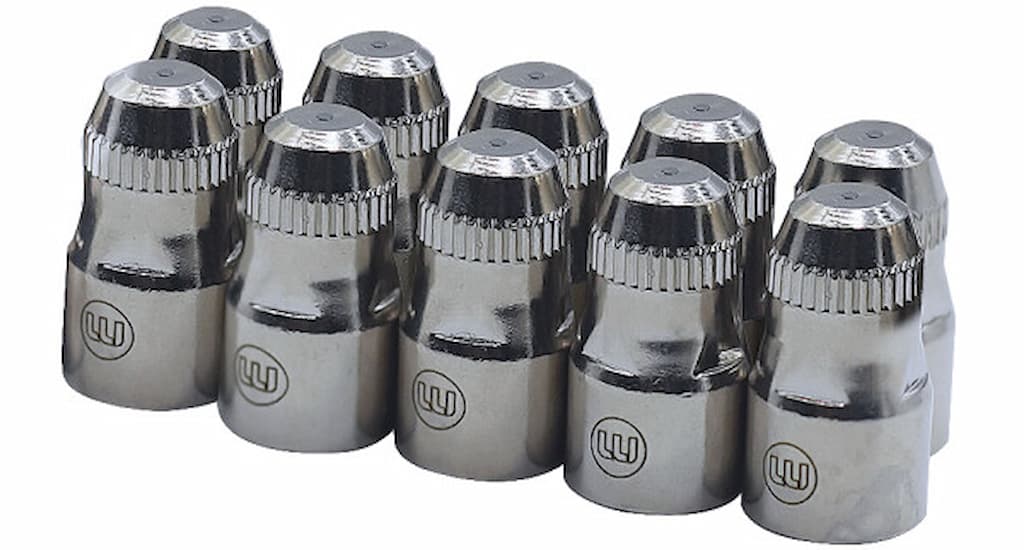
Plasma-cutting stainless parts
Disadvantages of Plasma Cutting Stainless Steel
Now, let’s figure out some of the demerits of Plasma cutting;
- Plasma cutting may not be suitable for very thin stainless steel sheets (less than 1 mm) due to the risk of warping and distortion.
- Plasma cutting with oxygen as the plasma gas can lead to increased oxidation of the cut edges, requiring additional post-processing to remove oxide layers.
- Initial investment in plasma cutting equipment, including the plasma cutter, power source, and consumables, can be relatively high compared to other cutting methods
- Plasma cutting is limited to conductive materials, so non-conductive coatings or layers on stainless steel surfaces may affect cutting quality.
Why Choose Pro-lean For Plasma Metal Cutting Services?
Prolean’s plasma cutting services will produce intricate parts with high precision on a broad array of materials such as stainless steel, aluminum, and steel. Prolean is a unique platform where our technical team of experts will select the ideal technique for your cutting needs at affordable prices.
Contact us today, and let’s take the first step together toward achieving impeccable results.
Read more:
- Plasma Arc Welding: Advancing Precision and Efficiency in Metal Joining
- Capabilities of Non-Shear Cutting
- Fundamentals of Sheet Metal Cutting Processes
Try Prolean Now!
Summing Up
Plasma Cutting has become the best affordable metal-cutting technique that provides both accuracy and long-term dependability. For cutting metal pieces of different thicknesses and creating complex shapes, it is highly recommended to utilize Plasma.
CNC in a plasma cutting approach operates under digital orders which define the specifications of cutting requirements. Cutting using a CNC plasma takes specific training and expertise.
The increasing demand for plasma cutters in various industries is attributed to their cost-effectiveness, superior finishing, and faster operation. Despite its pros and cons, plasma-cutting stainless steel remains a highly esteemed and crucial production method, meeting the growing need for specialized, and top-quality complex geometries.
FAQs
1- How does the thickness of the stainless steel material affect the plasma-cutting process?
The thickness of the stainless steel material significantly affects the plasma-cutting process. Thinner materials require lower power settings and faster cutting speeds, while thicker materials necessitate higher power and slower cutting speeds to achieve optimal results.
2- What factors influence the decision to use different types of plasma cutting on stainless steel?
Certain factors affect that aspect, for instance,
- Material thickness,
- Precision requirements,
- Application complexity, and
- Cost considerations.
3- How does the choice of plasma cutting speed impact the quality of cuts in stainless steel?
Cutting speed directly affects productivity and cut quality. Proper adjustment of cutting speed balances efficiency with cut quality, ensuring smooth, consistent cuts without compromising accuracy or edge integrity.
4- Can plasma cutting be used to make bevel cuts in stainless steel?
Yes, it can be used to make bevel cuts in stainless steel. With appropriate machine settings and torch angles, plasma cutting machines can be adjusted to produce beveled edges on stainless steel materials.
5- Why Stainless Steel is a good choice for plasma cutting?
Stainless steel is a preferred choice for plasma cutting due to its excellent conductivity, resistance to corrosion, and versatility in a wide range of applications
6- What safety considerations should be kept in mind during plasma cutting?
It’s important to wear appropriate personal protective equipment (PPE), including safety glasses, gloves, and flame-resistant clothing. Also, ensure proper ventilation to remove fumes and smoke generated during cutting.



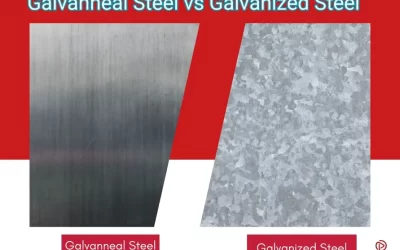
Hello very nice blog!! Man .. Excellent details on plasma stainless cutting . I am satisfied to find numerous plasma cutting tips helpful
within the post, we’d like develop more techniques in this regard, thank you
for sharing. . . . . .